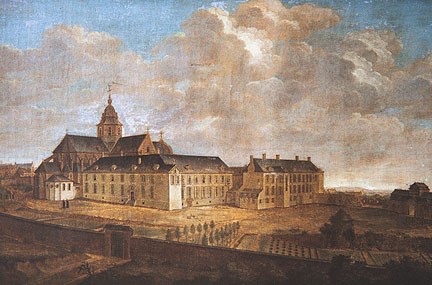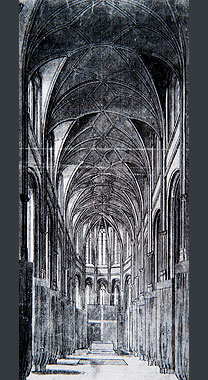Provenance
No reference to NG2790 has been found before 1600, when it was in a chapel dedicated to the Virgin in the church of the Benedictine Abbey of Geraardsbergen (Grammont) in East Flanders, south of Ghent and west of Brussels (fig.7). In August 1600 Albert and Isabella, the rulers of the Spanish Netherlands, returning from Oudenaarde to Brussels, visited the abbey, saw the painting and asked to have it.1 On 5 April 1601 Albert authorised a payment of £2,100 to the abbot for its purchase2 and on 18 May 1601 it was recorded that the painter Gijsbrecht van Veen, residing in Brussels, had been sent to Geraardsbergen to buy from the Abbey of St Andrew the painting in oil on panel of the 'Adoration of the Three Kings or Magi', 2 ¾ ells high by 2 ells wide, with its plain frame. It was to be placed on the high altar of the chapel of the palace in Brussels (fig.8).3 The picture was reframed and installed in the chapel in 1603.4 It was mentioned in several sources of the seventeenth and early eighteenth centuries.5


Three descriptions are particularly informative: that by François-Nicolas Baudot, sieur du Buisson et d'Aubenay (c.1590–1652), commonly called Dubuisson-Aubenay, a Frenchman who visited the Low Countries several times between 1623 and 1627;6 that by Chifflet (1650);7 and that by Losano, who was employed in the palace chapel between 1692 and 1712.8 The framing elements were of gilded wood. There were two fluted columns with a 'frontispiece' above, surmounted by a cross and, at a lower level, by two angels. On a raised oval on the tympanum was the dedicatory inscription: Deo Opt. Max. D.D. MDCIII (Given and dedicated to the best and greatest God, 1603) and on an architrave above the picture was a polygonal plaque bearing a Latin inscription in gold letters on a blue ground: Aurum, Myrrham, Thus regique hominique deoque dona ferunt (They bring as gifts to the king and the man and the God gold, myrrh and frankincense). During Lent and Advent the painting was replaced or covered by another, in grisaille, of the Crucifixion.
The 'Adoration' remained on the altar until the fire of February 1731 which destroyed the palace but spared the chapel.9 It was subsequently put back in the chapel10 and remained there for some time. The building was demolished in the 1770s but the picture had been removed by Charles of Lorraine (1712–1780), Governor of the Austrian Netherlands from 1744. In the inventory taken after his death it was listed as 'A picture representing “The Adoration of the Magi”, painted by Halbert Dur [i.e. Albrecht Dürer], on panel, 5½ by 5 feet'.11 It was included in the sale of Charles's effects in Brussels on 21 May – 27 June 1781. According to undated notes made by François Mols (1722–1791),12 it passed into the possession of 'Mr. Le Cock, Conseiller-Pensionnaire-Adjoint des Etats de Brabant': Emmanuel-Marie de Cock (1742–1796), who was from 1776 Pensionary of Brussels and Greffier-Pensionary of the Estates of Brabant.13 He died in exile at Brno; meanwhile NG2790 was said to have been owned by M. van Fulens at The Hague, about whom nothing has been discovered.
NG2790 is thought to have been the 'tableau unique' which in May 1787 was exhibited in the house in Leicester Square, London, of the auctioneer John Greenwood (c.1729–1792). 'A Foreign Gentleman has brought into England a picture that astonishes every person who has seen it ... It is to be viewed ... from ten in the morning till six in the evening, at one shilling per person.'14 On 26 April 1788 it was auctioned by Greenwood, in his rooms in Leicester Square, with a 'Select Collection of Cabinet Pictures, Just consigned from Abroad, the Property of M. VAN FULENS, late of the Hague'. Billed as 'a superb picture by J. de Mabuse ... which merits a place in the first Cabinet in Europe', it was the subject of a 'description ... which lays on the table'.15 This 'Description' was a printed sheet which was perhaps prepared for the exhibition of 1787 and in which the history of the painting was set out, with much scholarly detail.16 The buyer's name has not been discovered. By 1795 NG2790 was in the possession of the dealer and writer Michael Bryan (1757–1821). It was No. 180 in the 'superlatively capital assemblage of Valuable Pictures ... to be sold by private contract at Bryan's Gallery, Savile Row, 27 April 1795 (& subsequently)'.17 On 16 March 1796 Bryan acknowledged having received from the Earl of Carlisle a picture by Poussin, valued at 200 guineas, 'in part payment for a Picture sold to his Lordship by John de Mabuse representing the Wiseman's offering, for the sum of Four Hundred Guineas'. On 28 June 1796, he issued a receipt for an additional 300 guineas for the same picture.18 Farington reported in his diary on 20 March 1796 that, at Bryan's Gallery, 'Lord Carlisle has bought the large high finished picture by [Gossart]'.19
Lord Carlisle was the great collector Frederick Howard (1748–1825), 5th Earl of Carlisle. He took NG2790 to his country seat, Castle Howard in Yorkshire, where by August 1796 it was placed, with other sixteenth-century pictures, in a small room. 'The better to ensure its safe preservance, a covering of green silk fitted into a wooden frame, guards it from danger; - it is constantly locked-up, unless when opened for the inspection of visitors.'20 No. 17 in the Castle Howard catalogues of 1805 and 1814,21 it passed to the Earl's son George (1778–1848), 6th Earl of Carlisle, his son George William Frederick (1802–1864), 7th Earl, and his brother William George (1808–1889), 8th Earl. In 1884 it was being restored by (William) Morrill in London.22 Moved in 1885 from Castle Howard to Naworth Castle in Cumberland,23 it was inherited by the 8th Earl's nephew, George James Howard (1843–1911), 9th Earl of Carlisle. Shortly before his death, the 9th Earl, who was an amateur painter and who had been for more than 30 years an influential Trustee of the National Gallery, had agreed to offer the 'Adoration' to the Gallery at a price much below its market value. His widow, Rosalind Frances (née Stanley, 1845–1921), immediately put his wishes into effect by offering the picture for £40,000.24 The Earl's will was proved on 14 June 1911; the Dowager Countess then sent the painting to the Gallery, where it remained on loan, though not on public exhibition, until the money was raised for its purchase.25 Lady Carlisle's offer was accepted on 3 August26 and, though the purchase was not completed until 8 January 1912, an official announcement of the acquisition was made on 1 September 1911, when the picture was placed on exhibition.27 The government made a special grant of £15,000, plus the legacy and estate duties (£2,776) payable by Lady Carlisle in respect of the picture, on the understanding that the annual purchase grant of £5,000 should be suspended for the year 1912–13. (The Lords of the Treasury had attempted to suspend the purchase grant for four years but the Prime Minister, H.H. Asquith, wrote from Downing Street on 24 August 1911 to curb their parsimony.28) The Gallery raised £13,000: £10,020 from the Temple-West Fund; £2,380 from the Loan Exhibition Fund; and £600 from the Grant-in-Aid account. Alfred Charles de Rothschild (1848–1918) contributed £500; Edward Priaulx Tennant (1859–1920), first Baron Glenconner, gave £500; Edward Cecil Guinness (1847–1927), first Earl of Iveagh, donated £1,000. The remaining £10,000 came from the National Art Collections Fund and included subscriptions of £500 from George Nathaniel Curzon (1859–1925), Earl Curzon of Kedleston, and £50 from Messrs Sully.29 The Chairman and Honorary Secretaries of the Fund wrote on 31 August 1911:
The satisfaction of the Committee of the National Art-Collections Fund in being able to give decisive help towards so notable an acquisition has been increased by their sense of the extremely favourable terms upon which the picture has been offered to the nation by the Dowager Countess of Carlisle, acting in accordance with the known wishes of her late husband, and without the intervention of agent or middle-man. There was no picture in England better worth preserving for the nation: none which should be a more splendid or more popular addition to the Gallery ...30
To celebrate the acquisition, a book was published: 'The "Adoration of the Magi" by Jan Mabuse Formerly in the Collection of the Earl of Carlisle'. The text was by Maurice W. Brockwell (1869–1958), who was employed between 1907 and 1911 by Sir Charles Holroyd, the Director of the Gallery, to revise the catalogues. Brockwell's book was privately printed by The Athenaeum Press. This seems to have been the first occasion on which the acquisition of an important painting for the Gallery was commemorated by the publication of a monographic study.
